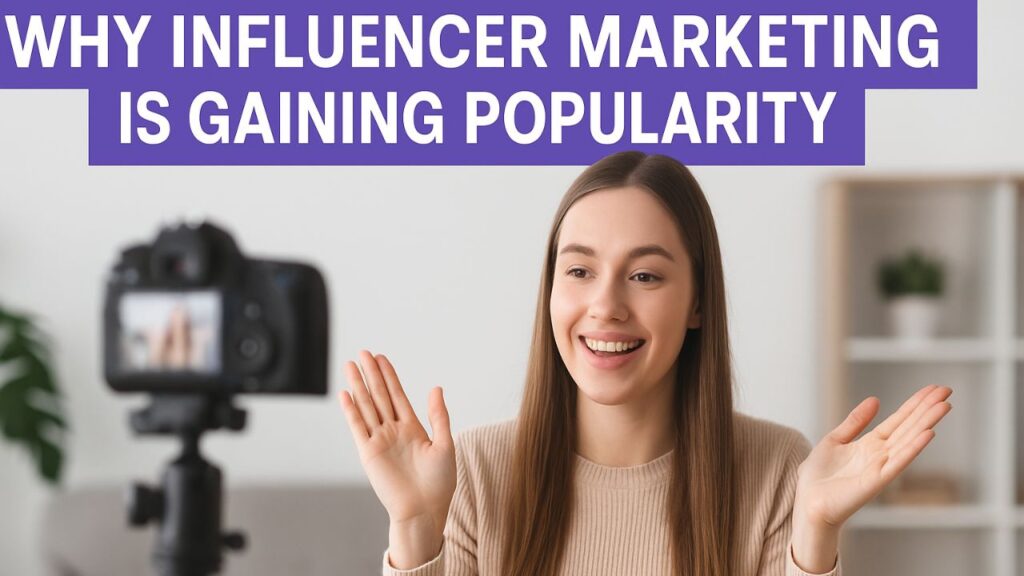In recent years, influencer marketing has emerged as a pivotal strategy in the digital marketing landscape. This approach involves collaborating with individuals who have a significant online following to promote products or services. The surge in its popularity can be attributed to various factors that align with the evolving consumer behavior and technological advancements.
Table of Contents
Understanding Influencer Marketing
Influencer marketing is a form of social media marketing that leverages endorsements and product mentions from influencers—individuals who have a dedicated social following and are viewed as experts within their niche. This strategy capitalizes on the trust that influencers have built with their audience, making their recommendations more impactful than traditional advertising methods.
Factors Contributing to the Rise of Influencer Marketing
1. Authenticity and Trust
Consumers today are increasingly skeptical of traditional advertisements. They seek genuine recommendations from individuals they trust. Influencers, having cultivated relationships with their followers, offer a sense of authenticity that resonates with audiences. Their content often feels more personal and relatable, leading to higher engagement rates.
2. Targeted Reach
It allows brands to reach specific demographics effectively. By partnering with influencers whose followers align with the brand’s target audience, companies can ensure their message reaches the right people. This targeted approach enhances the efficiency of marketing campaigns.
3. Cost-Effectiveness
Compared to traditional advertising channels, influencer marketing can be more cost-effective. Especially when collaborating with micro or nano-influencers, brands can achieve substantial reach and engagement without the hefty price tag associated with mainstream media advertising.
4. Enhanced Content Strategy
Influencers are adept content creators. Their ability to produce engaging and creative content provides brands with high-quality material that can be repurposed across various marketing channels. This collaboration enriches the brand’s content strategy and maintains audience interest.
5. Improved SEO and Online Visibility
Collaborations with influencers often result in backlinks to the brand’s website, which can enhance search engine rankings. Additionally, increased brand mentions and shares across social media platforms contribute to a stronger online presence, driving more organic traffic to the brand’s digital assets.
6. Adaptability to Market Trends
It is highly adaptable to emerging trends. Whether it’s the rise of short-form video content, live streaming, or the integration of augmented reality, influencers are quick to adopt new formats, ensuring that brand promotions remain current and engaging.
7. Measurable Results
With the availability of advanced analytics tools, brands can track the performance of influencer marketing campaigns in real-time. Metrics such as engagement rates, click-through rates, and conversion rates provide valuable insights, allowing for data-driven decision-making and optimization of marketing strategies.
8. Building Long-Term Relationships
Establishing ongoing partnerships with influencers can lead to more consistent and authentic brand representation. Long-term collaborations enable influencers to become more integrated with the brand, fostering deeper connections with their audience and enhancing brand loyalty.
The Future Outlook

As digital age continues to evolve, influencer marketing is poised to become even more integral to brand strategies. The continuous shift towards personalized and authentic content, coupled with technological advancements, will likely see influencer marketing adapting and growing in new directions. Brands that recognize and harness the power of influencer collaborations will be better positioned to connect with their audiences in meaningful ways.
Frequently Asked Questions (FAQ)
Q1: What is influencer marketing?
A1: Influencer marketing is a strategy that involves partnering with individuals who have a significant online following to promote products or services. These influencers leverage their credibility and relationship with their audience to endorse brands authentically.
Q2: Why is influencer marketing more effective than traditional advertising?
A2: Influencer marketing often yields higher engagement because it feels more personal and trustworthy. Unlike traditional ads, influencer content is perceived as genuine recommendations, leading to increased consumer trust and action.
Q3: How do brands choose the right influencer?
A3: Brands typically assess an influencer’s relevance to their target audience, engagement rates, content quality, and alignment with brand values. Tools and platforms are available to assist in identifying suitable influencers based on these criteria.
Q4: Is influencer marketing suitable for all types of businesses?
A4: While particularly effective for consumer-facing brands, influencer marketing can be adapted for various industries. The key is to identify influencers whose audience aligns with the brand’s target market.
Q5: How is the success of an influencer marketing campaign measured?
A5: Success is measured using metrics such as engagement rates, website traffic, conversion rates, and return on investment (ROI). These indicators help determine the effectiveness of the campaign and inform future strategies.
Q6: What are micro and nano-influencers?
A6: Micro-influencers typically have between 10,000 to 100,000 followers, while nano-influencers have fewer than 10,000. Despite smaller followings, they often boast higher engagement rates and more niche audiences, making them valuable for targeted campaigns.
Q7: Are there any risks associated with influencer marketing?
A7: Potential risks include misalignment between the influencer’s content and brand values, lack of authenticity, or non-compliance with advertising regulations. Thorough vetting and clear communication can mitigate these risks.
Q8: How can small businesses benefit from influencer marketing?
A8: Small businesses can leverage influencer marketing by collaborating with micro or nano-influencers who cater to specific niches. This approach allows for targeted outreach and can be more cost-effective than traditional advertising methods.



